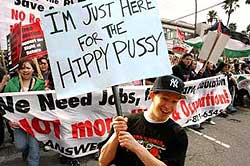The Forces Of Good:
Alito
Kennedy (if barely)
Roberts
Scalia
Thomas
The Forces Of Evil:
Breyer
Ginsburg
Souter
Stevens
Note that Justice Kennedy is just barely hanging on here and is somewhat of a wuss:
Justice Kennedy agreed that the Court has jurisdiction to decide these cases and that respondents' student assignment plans are not narrowly tailored to achieve the compelling goal of diversity properly defined, but concluded that some parts of the plurality opinion imply an unyielding insistence that race cannot be a factor in instances when it may be taken into account.One can only hope this leads to a reconsideration of the convoluted reasoning of Grutter v. Bollinger, where "diversity" was upheld to be a compelling state interest.
And in court decision after court decision, the trouble has more often than not come not from the Clinton Democrat appointees, but from the RINO Republican appointees (Souter, Stevens, to say nothing of the former Justice O'Connor, and Anthony Kennedy comes dangerously close)
Justice Thomas just kicks ass:
Lacking a cognizable interest in remediation, neither of these plans can survive strict scrutiny because neither plan serves a genuinely compelling state interest. The dissent avoids reaching that conclusion by unquestioningly accepting the assertions of selected social scientists while completely ignoring the fact that those assertions are the subject of fervent debate. Ultimately, the dissent's entire analysis is corrupted by the considerations that lead it initially to question whether strict scrutiny should apply at all. What emerges is a version of "strict scrutiny" that combines hollow assurances of harmlessness with reflexive acceptance of conventional wisdom. When it comes to government race-based decisionmaking, the Constitution demands more.To which Justice Stevens replies with truly pathetic vaporing:
(...)
Most of the dissent's criticisms of today's result can be traced to its rejection of the color-blind Constitution. See post, at 29. The dissent attempts to marginalize the notion of a color-blind Constitution by consigning it to me and Members of today's plurality.19 See ibid.; see also post, at 61. But I am quite comfortable in the company I keep. My view of the Constitution is Justice Harlan's view in Plessy: "Our Constitution is color-blind, and neither knows nor tolerates classes among citizens." Plessy v. Ferguson, 163 U. S. 537, 559 (1896) (dissenting opinion). And my view was the rallying cry for the lawyers who litigated Brown. See, e.g., Brief for Appellants in Brown v. Board of Education, O. T. 1953, Nos. 1, 2, and 4 p. 65 ("That the Constitution is color blind is our dedicated belief"); Brief for Appellants in Brown v. Board of Education, O. T. 1952, No. 1, p. 5 ("The Fourteenth Amendment precludes a state from imposing distinctions or classifications based upon race and color alone");20 see also In Memoriam: Honorable Thurgood Marshall, Proceedings of the Bar and Officers of the Supreme Court of the United States, X (1993) (remarks of Judge Motley) ("Marshall had a 'Bible' to which he turned during his most depressed moments. The 'Bible' would be known in the legal community as the first Mr. Justice Harlan's dissent in Plessy v. Ferguson, 163 U. S. 537, 552 (1896). I do not know of any opinion which buoyed Marshall more in his pre-Brown days ...").
The dissent appears to pin its interpretation of the Equal Protection Clause to current societal practice and expectations, deference to local officials, likely practical consequences, and reliance on previous statements from this and other courts. Such a view was ascendant in this Court's jurisprudence for several decades. It first appeared in Plessy, where the Court asked whether a state law providing for segregated railway cars was "a reasonable regulation." 163 U. S., at 550. The Court deferred to local authorities in making its determination, noting that in inquiring into reasonableness "there must necessarily be a large discretion on the part of the legislature." Ibid. The Court likewise paid heed to societal practices, local expectations, and practical consequences by looking to "the established usages, customs and traditions of the people, and with a view to the promotion of their comfort, and the preservation of the public peace and good order." Ibid. Guided by these principles, the Court concluded: "[W]e cannot say that a law which authorizes or even requires the separation of the two races in public conveyances is unreasonable, or more obnoxious to the Fourteenth Amendment than the acts of Congress requiring separate schools for colored children in the District of Columbia." Id., at 550-551.
The segregationists in Brown embraced the arguments the Court endorsed in Plessy. Though Brown decisively rejected those arguments, today's dissent replicates them to a distressing extent. Thus, the dissent argues that "[e]ach plan embodies the results of local experience and community consultation." Post, at 47. Similarly, the segregationists made repeated appeals to societal practice and expectation. See, e.g., Brief for Appellees on Reargument in Briggs v. Elliott, O. T. 1953, No. 2, p. 76 ("[A] State has power to establish a school system which is capable of efficient administration, taking into account local problems and conditions").21 The dissent argues that "weight [must be given] to a local school board's knowledge, expertise, and concerns," post, at 48, and with equal vigor, the segregationists argued for deference to local authorities. See, e.g., Brief for Kansas on Reargument in Brown v. Board of Education, O. T. 1953, No. 1, p. 14 ("We advocate only a concept of constitutional law that permits determinations of state and local policy to be made on state and local levels. We defend only the validity of the statute that enables the Topeka Board of Education to determine its own course").22 The dissent argues that today's decision "threatens to substitute for present calm a disruptive round of race-related litigation," post, at 2, and claims that today's decision "risks serious harm to the law and for the Nation," post, at 65. The segregationists also relied upon the likely practical consequences of ending the state-imposed system of racial separation. See, e.g., Brief for Appellees on Reargument in Davis v. County School Board, O. T. 1953, No. 3, p. 37 ("Yet a holding that school segregation by race violates the Constitution will result in upheaval in all of those places not now subject to Federal judicial scrutiny. This Court has made many decisions of widespread effect; none would affect more people more directly in more fundamental interests and, in fact, cause more chaos in local government than a reversal of the decision in this case").23 And foreshadowing today's dissent, the segregationists most heavily relied upon judicial precedent. See, e.g., Brief for Appellees on Reargument in Briggs v. Elliott, O. T. 1953, No. 2, p. 59 ("[I]t would be difficult indeed to find a case so favored by precedent as is the case for South Carolina here").24
The similarities between the dissent's arguments and the segregationists' arguments do not stop there. Like the dissent, the segregationists repeatedly cautioned the Court to consider practicalities and not to embrace too theoretical a view of the Fourteenth Amendment.25 And just as the dissent argues that the need for these programs will lessen over time, the segregationists claimed that reliance on segregation was lessening and might eventually end.26
There is a cruel irony in The Chief Justice's reliance on our decision in Brown v. Board of Education, 349 U. S. 294 (1955). The first sentence in the concluding paragraph of his opinion states: "Before Brown, schoolchildren were told where they could and could not go to school based on the color of their skin." Ante, at 40. This sentence reminds me of Anatole France's observation: "[T]he majestic equality of the la[w], forbid[s] rich and poor alike to sleep under bridges, to beg in the streets, and to steal their bread."1 The Chief Justice fails to note that it was only black schoolchildren who were so ordered; indeed, the history books do not tell stories of white children struggling to attend black schools.2 In this and other ways, The Chief Justice rewrites the history of one of this Court's most important decisions. Compare ante, at 39 ("history will be heard"), with Brewer v. Quarterman, 550 U. S. ___, ___ (2007) (slip op., at 11) (Roberts, C. J., dissenting) ("It is a familiar adage that history is written by the victors").Oh up yours. The schools in these cases were trying to assign students to places solely on the basis of race, not financial need or economic circumstance.
But it gets worse: Justice Stevens prattles on:
The Chief Justice rejects the conclusion that the racial classifications at issue here should be viewed differently than others, because they do not impose burdens on one race alone and do not stigmatize or exclude.3 The only justification for refusing to acknowledge the obvious importance of that difference is the citation of a few recent opinions--none of which even approached unanimity--grandly proclaiming that all racial classifications must be analyzed under "strict scrutiny." See, e.g., Adarand Constructors, Inc. v. Peńa, 515 U. S. 200, 227 (1995). Even today, two of our wisest federal judges have rejected such a wooden reading of the Equal Protection Clause in the context of school integration. See 426 F. 3d 1162, 1193-1196 (CA9 2005) (Kozinski, J., concurring); Comfort v. Lynn School Comm., 418 F. 3d 1, 27-29 (CA1 2005) (Boudin, C. J., concurring). The Court's misuse of the three-tiered approach to Equal Protection analysis merely reconfirms my own view that there is only one such Clause in the Constitution. See Craig v. Boren, 429 U. S. 190, 211 (1976) (concurring opinion).4Which is precisely the problem. Justice Stevens still pushes the "living breathing document" crap vs. a true rule of law, which is like a yardstick. Dare I say it, a "wooden" yardstick!
Justice Stevens concludes with this monumental statement:
It is my firm conviction that no Member of the Court that I joined in 1975 would have agreed with today's decision.Sorry, Justice Stevens, but "The Lone Ranger", were he still alive, would certainly have agreed with it.
Butg even if that is true with respect to the other justices besides Rhenquist, then perhaps it's time for Justice Stevens to just retire or die, then?











No comments:
Post a Comment